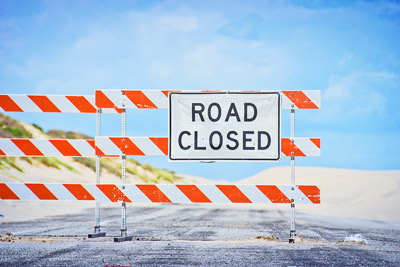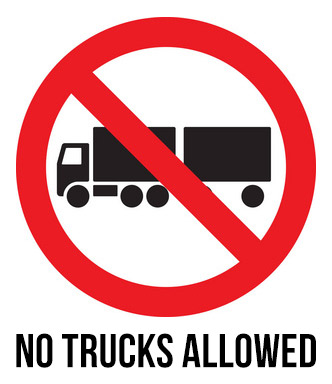You have probably seen a Do Not Enter sign at some point in your life. They are usually found surrounding construction sites, rail lines, exit ramps, roadways, private property, and more.
What you might not have thought about is where you can buy them. Or, if you aren’t looking to buy a sign, you are perhaps here to find out a little more about them.
We cover everything that you need to know, from what to look for to where to get them.
Where to Buy a Do Not Enter Sign?

When you start looking into it, you’ll find that you can buy a Do Not Enter sign almost anywhere. They are available in many stores, especially hardware stores, but you can also find them in stores that deal with any printing, such as stationery wholesalers and print stores. Specialized construction stores are also a great place to look.
When it comes to the online world, many sites sell Do Not Enter signs. Of course, large wholesale sites like Amazon stock them, but you may want to look for a more specialized retailer, depending on what you are looking for and what the sign is for, but we will address that later in the article.
If you are looking for a sign that alerts people that they cannot enter an area, then a local hardware store or an online retailer is the place to look.
What Does a Do Not Enter Sign Mean, and Do I Need to Follow it?

The real question is, does a Do Not Enter sign mean that you cannot legally enter that area?
One of the most common Do Not Enter signs is on a roadway, and they are there to maintain the safety of the roads. If you do not follow the laws of the road, and note that driving your vehicle along a road that has one of these signs would be breaking the law, then you are putting yourself and others in danger.
The second most common use of a Do Not Enter sign will be to protect people from dangerous areas. This could be to stop people from crossing train tracks, entering construction sites, or being in a place where they could be harmed (from something like electrical shock).
In these instances, it is not entirely black and white when it comes to the law. You may find a sign on an electrical box and open that box without facing criminal charges, while you may bypass one on a rail line and be arrested for it. If you are thinking of ignoring a sign, and we don’t recommend that you do, you should research your local laws to gain better insight.
The final common use is on private property. Again, this is a grey area. If we take Scotland, for example, there is no such thing as private property. So, you can freely wander past a Do Not Enter sign on someone’s property in Scotland. That does not mean, of course, that you are still not putting yourself in danger. There may be an excavation, risk of electrocution, or an angry farmer on the other side of the sign.
Essentially, most Do Not Enter signs are there for your protection, and we recommend heeding them. By walking or driving past one, you are only putting yourself and those around you in danger.
Types of Do Not Enter Signs
There are many types of Do Not Enter signs, and they all convey the same message, though in slightly different ways. Here are the most common.
Do Not Enter

At their simplest, Do Not Enter signs will contain the words ‘Do Not Enter.’ You will usually find the words printed in white on a brightly colored background, usually red, to indicate danger. Some will have a slash across the sign, either horizontally or diagonally, while some will also contain the word ‘Stop.’
You can find this type of sign in many shapes, including circle, square, and hexagon.
Other Phrases

While ‘Do Not Enter’ is the phrase of choice, you can find Do Not Enter signs that use alternate wording.
For example, it is not uncommon to see ‘Wrong Way,’ ‘Road Closed,’ or ‘Sidewalk closed.’ These signs convey the same message but add more specifics to give you additional context to the situation. If we take the example of the road closed sign, we can see that it is the immediate area that is dangerous and not the destination past this road. It may also be safe for pedestrians, so the Do Not Enter connotation is only for vehicles.
You might also see signs such as ‘No Exit,’ ‘No Left Turn,’ ‘Private Property,’ and other such messages. All convey some meaning of Do Not Enter but add more specifics to the scenario.
Visual Signs

In the previous section, we talked about a sign that read, ‘No Left Turn.’ This can also be conveyed as an image, such as an arrow that is bent towards the left with a slash running diagonally through it. Most people would recognize what the sign means at a glance. You can also find similar images with a pedestrian and a slashing line through it and other such images.
Visual signs are great when you cannot convey the meaning in only a few words. Brevity is important, especially if someone is traveling quickly in a vehicle.
Uses for Do Not Enter Signs
Safety

As you have seen in the above sections, a Do Not Enter sign is mostly about safety. When you see one, they are there to keep you safe, and you might use one yourself to keep other people safe. If there is any danger, and someone might wander into that, you can protect that person from the danger and protect yourself from a lawsuit.
Security

A Do Not Enter sign can also be used to add extra security to an area. People are conditioned to recognize danger when they see a Do Not Enter sign, and you can use that to your advantage. If you work somewhere with valuable items, such as on a car lot, you can add a Do Not Enter sign to deter people from entering the area with the vehicles.
Traffic Control

If you want to ensure safety on the road, Do Not Enter signs can be used to stop vehicles from colliding with each other. Just be sure to check with your local authorities to ensure that you are allowed to display Do Not Enter signs on a roadway.
What to Look for in a Do Not Enter Sign
There are so many Do Not Enter signs out there that it can be hard to make a choice. You can narrow it down by thinking about some of these things.
Color

If someone can be seriously harmed by bypassing your Do Not Enter sign, then you should make the sign as obvious as possible. This means using contrasting colors to help the sign stand out. Most signs are red to indicate danger, and almost everyone associates red signs with danger, so you cannot go wrong by investing in a red Do Not Enter sign.
Size

You do not want your sign to be overbearing, but, as with the color, you want to make sure that it is seen. Think about where you are going to put your sign, and make sure that it will be visible. If you need to invest in a large sign, then that is better than having someone injure themselves or worse.
Reflective Coating

Your sign may be fine during the day, but what about at night? If your sign is to offer protection twenty-four hours a day, you should invest in a reflective sign. Of course, this will mostly be beneficial to those who are driving, as there needs to be some light to reflect off the sign.
Wording

Buying a Do Not Enter sign might cover all of your bases, but it might not be right for your situation. If you only need to keep out specific vehicles or people, look for a sign that says that.
Other Signs Seen with Do Not Enter Sign

The most common sign that you will see will be a private property sign, which may or may not be legal depending on the area you live in.
You might also see a sign that offers more clarification on the Do Not Enter sign. For example, if you see a Do Not Enter sign on a farm, you might also see a sign that alerts you to the presence of a bull in a field.
Popular Articles on ComproGear
Compression Stockings mmHg Chart Type of Compression Stockings
FAQ:

Where are Do Not Enter signs Found?
Do Not Enter signs are often found on roadways to stop drivers from driving the wrong way and causing accidents, but you will also find them anywhere it would be dangerous to enter. For example, if there is an excavation as part of a construction site, or a threat of electrocution from overhead power lines, there will be a Do Not Enter sign.
What can happen if you “Enter” a Do Not Enter sign area?
That depends on who put the sign there and the laws in your area. If on the road, it is always wise to adhere to them, and you will be breaking the law if you do not. If a Do Not Enter sign is posted on property, it will depend on the laws of the land whether it is legal to enter or not. Of course, you may be putting yourself in danger if you do enter, irrelevant of the laws.
Can anyone set up a stop sign?
If it is on your own property, there is nothing stopping you from putting up a stop or Do Not Enter sign, but that does not mean that people have to follow it. You are not allowed to put one up on someone else’s property.
Can I buy a Do Not Enter Sign for my driveway?
Yes, you can buy one and display one, but as mentioned before, it might not be illegal for someone to ignore it.
What is MUTCD Compliant?
The Manual on Uniform Traffic Control Devices for Streets and Highways defines the standards nationwide for the installation of traffic control devices. You can find the manual online if you want to adhere to the standards.
Do bicyclists have to abide by Do Not Enter signs?
If it is a generic Do Not Enter sign, then they do. Some signs adhere only to motorized vehicles or exempt bicycles.
What should you do if a Do Not Enter sign has fallen?
If it is a sign that you put up, you can replace it, but if the local authorities put it up, you should call them as soon as possible to let them know that the sign has fallen down.
This page last updated December 15, 2022